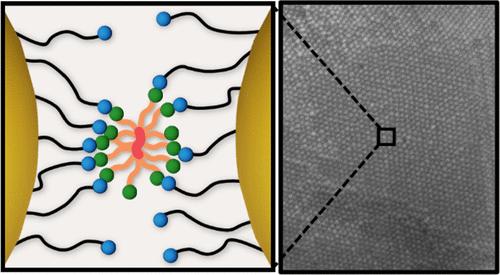当前位置:
X-MOL 学术
›
J. Am. Chem. Soc.
›
论文详情
Our official English website, www.x-mol.net, welcomes your feedback! (Note: you will need to create a separate account there.)
Rationally Designing the Supramolecular Interfaces of Nanoparticle Superlattices with Multivalent Polymers
Journal of the American Chemical Society ( IF 15.0 ) Pub Date : 2024-04-15 , DOI: 10.1021/jacs.4c02617 Carl J. Thrasher 1 , Fei Jia 1 , Daryl W. Yee 1 , Joshua M. Kubiak 1 , Yuping Wang 1 , Margaret S. Lee 1 , Michika Onoda 1 , A. John Hart 1 , Robert J. Macfarlane 1
Journal of the American Chemical Society ( IF 15.0 ) Pub Date : 2024-04-15 , DOI: 10.1021/jacs.4c02617 Carl J. Thrasher 1 , Fei Jia 1 , Daryl W. Yee 1 , Joshua M. Kubiak 1 , Yuping Wang 1 , Margaret S. Lee 1 , Michika Onoda 1 , A. John Hart 1 , Robert J. Macfarlane 1
Affiliation

|
In supramolecular materials, multiple weak binding groups can act as a single collective unit when confined to a localized volume, thereby producing strong but dynamic bonds between material building blocks. This principle of multivalency provides a versatile means of controlling material assembly, as both the number and the type of supramolecular moieties become design handles to modulate the strength of intermolecular interactions. However, in materials with building blocks significantly larger than individual supramolecular moieties (e.g., polymer or nanoparticle scaffolds), the degree of multivalency is difficult to predict or control, as sufficiently large scaffolds inherently preclude separated supramolecular moieties from interacting. Because molecular models commonly used to examine supramolecular interactions are intrinsically unable to examine any trends or emergent behaviors that arise due to nanoscale scaffold geometry, our understanding of the thermodynamics of these massively multivalent systems remains limited. Here we address this challenge via the coassembly of polymer-grafted nanoparticles and multivalent polymers, systematically examining how multivalent scaffold size, shape, and spacing affect their collective thermodynamics. Investigating the interplay of polymer structure and supramolecular group stoichiometry reveals complicated but rationally describable trends that demonstrate how the supramolecular scaffold design can modulate the strength of multivalent interactions. This approach to self-assembled supramolecular materials thus allows for the manipulation of polymer–nanoparticle composites with controlled thermal stability, nanoparticle organization, and tailored meso- to microscopic structures. The sophisticated control of multivalent thermodynamics through precise modulation of the nanoscale scaffold geometry represents a significant advance in the ability to rationally design complex hierarchically structured materials via self-assembly.
中文翻译:

合理设计纳米颗粒超晶格与多价聚合物的超分子界面
在超分子材料中,当限制在局部体积内时,多个弱结合基团可以充当单个集体单元,从而在材料构建块之间产生牢固但动态的键。这种多价原理提供了一种控制材料组装的通用方法,因为超分子部分的数量和类型都成为调节分子间相互作用强度的设计手柄。然而,在结构单元显着大于单个超分子部分(例如聚合物或纳米颗粒支架)的材料中,多价程度难以预测或控制,因为足够大的支架本身就阻止了分离的超分子部分相互作用。由于通常用于检查超分子相互作用的分子模型本质上无法检查由于纳米级支架几何形状而出现的任何趋势或突发行为,因此我们对这些大规模多价系统的热力学的理解仍然有限。在这里,我们通过聚合物接枝纳米粒子和多价聚合物的共组装来解决这一挑战,系统地研究多价支架的尺寸、形状和间距如何影响它们的集体热力学。研究聚合物结构和超分子基团化学计量的相互作用揭示了复杂但可合理描述的趋势,证明超分子支架设计如何调节多价相互作用的强度。因此,这种自组装超分子材料的方法可以操纵具有受控热稳定性、纳米颗粒组织和定制的介观到微观结构的聚合物-纳米颗粒复合材料。通过精确调节纳米级支架几何形状对多价热力学的复杂控制代表了通过自组装合理设计复杂分层结构材料的能力的重大进步。
更新日期:2024-04-15
中文翻译:

合理设计纳米颗粒超晶格与多价聚合物的超分子界面
在超分子材料中,当限制在局部体积内时,多个弱结合基团可以充当单个集体单元,从而在材料构建块之间产生牢固但动态的键。这种多价原理提供了一种控制材料组装的通用方法,因为超分子部分的数量和类型都成为调节分子间相互作用强度的设计手柄。然而,在结构单元显着大于单个超分子部分(例如聚合物或纳米颗粒支架)的材料中,多价程度难以预测或控制,因为足够大的支架本身就阻止了分离的超分子部分相互作用。由于通常用于检查超分子相互作用的分子模型本质上无法检查由于纳米级支架几何形状而出现的任何趋势或突发行为,因此我们对这些大规模多价系统的热力学的理解仍然有限。在这里,我们通过聚合物接枝纳米粒子和多价聚合物的共组装来解决这一挑战,系统地研究多价支架的尺寸、形状和间距如何影响它们的集体热力学。研究聚合物结构和超分子基团化学计量的相互作用揭示了复杂但可合理描述的趋势,证明超分子支架设计如何调节多价相互作用的强度。因此,这种自组装超分子材料的方法可以操纵具有受控热稳定性、纳米颗粒组织和定制的介观到微观结构的聚合物-纳米颗粒复合材料。通过精确调节纳米级支架几何形状对多价热力学的复杂控制代表了通过自组装合理设计复杂分层结构材料的能力的重大进步。



























 京公网安备 11010802027423号
京公网安备 11010802027423号